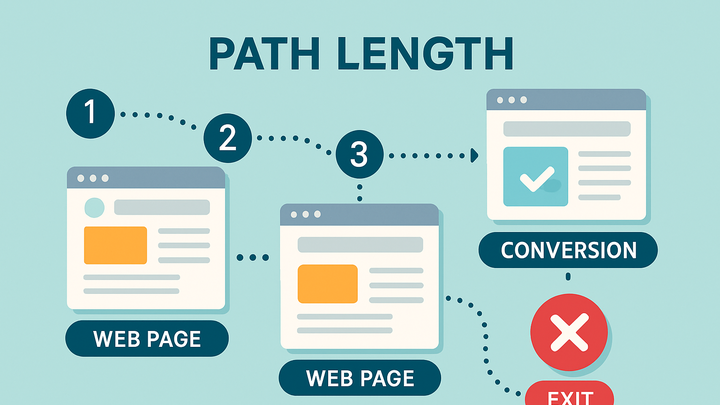Published on 2025-06-22T08:55:50Z
What is Path Length? Examples of Path Length in Analytics
Path Length in digital analytics measures the number of steps a user takes before reaching a defined endpoint, such as a conversion event or exit from the site. It provides insight into user engagement and the complexity of the user journey. By counting each interaction—pageview, event, or screen view—within a session (or across sessions for authenticated users), analysts can identify friction points and optimize flows.
Platforms like PlainSignal (a cookie-free, privacy-focused analytics tool) and Google Analytics 4 (GA4) offer built-in reports to visualize and analyze path length. Understanding this metric helps teams streamline navigation, improve conversion rates, and design more intuitive user experiences.
Path length
Count of user interactions before conversion or exit, vital for analyzing user journeys in digital analytics.
Understanding Path Length
Path Length represents the total number of tracked interactions a user completes before a defined endpoint. Each step can include pageviews, events, or screen views, depending on your analytics setup. This metric reveals how users navigate through your site or app, highlighting complexity, inefficiencies, and common paths to conversion or exit.
-
Session steps
A session step is any user action tracked within a single session, such as a pageview or event.
-
Pageview
Counts each time a user loads or reloads a page on your site.
-
Event
Tracks specific user interactions like button clicks, form submissions, or video plays.
-
-
Conversion paths
A conversion path is the sequence of interactions leading to a specific goal or exit on your site.
-
Conversion event
The defined action (e.g., purchase, signup) marking a successful outcome.
-
Path definition
Specifies starting and ending points to accurately measure the steps in between.
-
Why Path Length Matters
Analyzing path length provides critical insights into user behavior, funnel efficiency, and opportunities for optimization. By understanding how many steps users typically take, you can identify friction points, tailor content, and streamline navigation.
-
Behavior analysis
Longer or shorter path lengths indicate varying engagement levels, helping you understand how users interact with your content.
-
Conversion optimization
By studying path length, you can pinpoint drop-off spots and remove barriers to improve conversion rates.
-
Marketing attribution
Path length data aids in attributing value to different channels or campaigns based on their position in the user journey.
Measuring Path Length in Analytics Platforms
Different analytics tools offer specialized reports and methods to measure path length. Below are examples using PlainSignal and Google Analytics 4.
-
PlainSignal
PlainSignal is a privacy-friendly analytics solution that captures path length without relying on cookies.
-
Code snippet
Add the following script to the
<head>of your HTML:<link rel="preconnect" href="//eu.plainsignal.com/" crossorigin /><script defer data-do="yourwebsitedomain.com" data-id="0GQV1xmtzQQ" data-api="//eu.plainsignal.com" src="//cdn.plainsignal.com/plainsignal-min.js"></script> -
Dashboard setup
Navigate to Insights > User Paths in PlainSignal to view the distribution of path lengths across sessions.
-
Limitations
PlainSignal’s cookie-free approach means path length is session-based and cannot stitch sessions across multiple devices or browsers.
-
-
Google analytics 4
GA4 provides a Path exploration report that visualizes user journeys, including average and individual path lengths.
-
Tag setup
Install the Global Site Tag in your pages:
<!-- Global site tag (gtag.js) - Google Analytics --> <script async src="https://www.googletagmanager.com/gtag/js?id=G-XXXXXXX"></script> <script> window.dataLayer = window.dataLayer || []; function gtag(){dataLayer.push(arguments);} gtag('js', new Date()); gtag('config', 'G-XXXXXXX', { 'send_page_view': true }); </script> -
Path exploration
In GA4, go to Explore > Path exploration to build a visual flow of user steps, analyze drop-offs, and measure path length statistics.
-
Cross-platform tracking
GA4’s unified user model can connect sessions across devices for authenticated users, giving more holistic path length insights.
-
Best Practices for Analyzing Path Length
Employ these best practices to ensure your path length analysis is accurate, actionable, and aligned with your business goals.
-
Define clear endpoints
Ensure conversion or exit events are well-defined and consistently implemented across your site or app.
-
Use event tracking
Capture key user interactions (e.g., form submissions, video plays) to enrich your path length data beyond simple pageviews.
-
Segment users
Analyze path length for different cohorts (new vs. returning, traffic source, device) to uncover deeper insights.
-
Review regularly
Monitor changes in path length over time to assess the impact of design updates, marketing campaigns, or site performance improvements.
